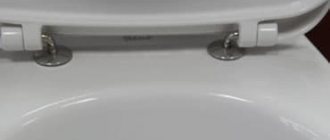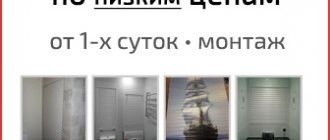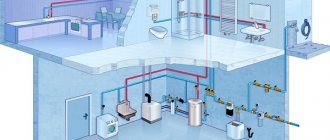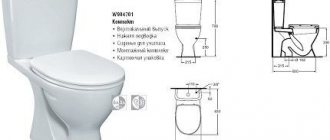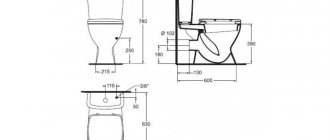Remodeling the bathroom will entail changing the location of the plumbing equipment. In order to move the toilet to another location, it is necessary to make changes to the existing utility system.
The cost of plumbing services is expressed in impressive figures. And if a professional designer is involved in the work, the total cost doubles. Let's try to figure out how to move a toilet with the best results at minimal cost.
The information provided in the article will make it possible to understand whether it is possible to move the toilet to another place yourself, without the help of a plumber.
Redevelopment
The layout of panel apartment buildings of the late twentieth century is not particularly comfortable. The design documentation is built on the principles of minimalism. As a rule, these are small-sized apartments with a combined bathroom.
Moving the toilet from the riser and dividing the combined bathroom into two isolated rooms is impossible without redevelopment. Before moving the toilet to another location, collect the necessary information.
What should you do first? The main thing is coordination. You cannot begin construction work without first documenting the upcoming change in living space.
There is only one legal way to make changes to project documentation - to obtain the appropriate permits.
According to the rules approved in 2010, a permit is issued on the basis of:
- certificates - conclusions from the BTI,
- technical passport,
- certificates of family composition,
- permission from Rospotrebnadzor,
- project with the desired changes,
- written consent of neighbors.
Is it legal or not?
The hot water supply riser is a common property.
This means that all actions with it in one way or another may affect the rights of other owners, i.e. all residents of the house. The work must be coordinated with the management company, and changes must be approved by the BTI and the architecture department, since the apartment plan is changing.
The main document defining the rules for using the common property of an apartment building is Decree of the Government of the Russian Federation of August 13, 2006 N 491.
According to the requirements of this law, the actions of one apartment owner should not infringe on the rights of other people living in the house. This means that uncoordinated actions with life support systems, which primarily include hot water supply and cold water risers, as well as sewage systems, entail liability.
It is determined by the Housing Code of the Russian Federation (Article 29), which establishes different types of liability, up to the seizure and sale of a problem apartment.
As a rule, the transfer of risers is done over a short distance, within 1 meter (usually even less). Such a transfer is acceptable, and no problems arise when coordinating the work. However, some owners go much further and plan to move the pipes to other rooms or corridors.
It must be taken into account that the installation of plumbing fixtures above residential premises is prohibited. However, there is no such restriction for pipelines. At the same time, a diversion is made from the riser to water collection devices, which poses a certain danger of flooding the premises of the lower floors.
When approving the project, you will have to justify the need and provide guarantees for the safety of residents of other apartments.
Relocating the riser is prohibited if the water supply conditions worsen as a result.
For example, when installing pipes of a smaller diameter, or when using unsuitable materials.
In addition, when replacing metal pipes with plastic ones, the requirements of the PUE are violated (the general potential equalization system changes).
This creates a danger for all residents of the upper floors. Another problem may arise that plastic pipelines are not able to withstand operating or pressure testing, which not all users are aware of.
The approval procedure requires a lot of time (usually at least 2 months), money and nerves. Often, officials, trying to play it safe, require a lot of unnecessary documents and certificates.
You must be prepared for a long walk through the authorities and not plan work ahead of time. Because of this, many owners make unapproved transfers at their own risk.
Technical features of the transfer
The second most popular option is to move the toilet and toilet from the riser to the side without additional redevelopment.
In this case, approval is not required. But there are technological nuances that must be paid attention to.
Increasing the length of the sewer pipe can provoke the formation of air jams and blockages. According to SNiP standards, the distance between the drainage device and the sewer outlet should not exceed 1.5 meters.
"Pitfalls" of these works
At first glance, moving plumbing equipment some distance from the riser seems to be a very simple and problem-free solution. But in reality this is not the case. Increasing the length of sewer pipes suitable for equipment can lead to trouble. When flushed, excessive vacuum will occur in them, which will cause a breakdown of the water seal in all nearby plumbing fixtures. This process will be accompanied by extremely unpleasant odors from the sewer and gurgling sounds.
Often, only moving plumbing equipment some distance from the sewer riser can solve the problem of optimizing space in the bathroom
Another problem is the increased likelihood of clogs. When moving equipment, the length of the pipe that connects the device to the sewer riser increases. Accordingly, the path of impurity lengthens. Theoretically, in any case, the wastewater will reach the sewer, but the likelihood of blockages increases many times over. Both problems can be solved with strict adherence to the requirements of the current SNiP. The document prohibits removing a plumbing fixture from the pipe further than 1.5 m.
Another important indicator is the slope of the pipeline. For parts with a diameter of 100 mm it should be at least 2 cm per meter. Parts with a diameter of 50 mm must be laid with a slope of no less than 3 cm per meter. This requirement must be strictly fulfilled. Reducing the slope reduces the speed of the drains, which can cause blockages. Too much slope is also undesirable. In this case, the water will pass through the pipes too quickly, leaving behind solid contaminants. They will gradually accumulate inside the pipes, preventing the free flow of liquid.
Very often, the owner of a bathroom realizes that in order to ensure a sufficient slope of the sewer pipe, the toilet will have to be raised, and the lifting height can be quite large. It all depends on the diameter of the pipe and the distance to which the device needs to be removed. There can be two options for solving the problem: either raise the floor in the bathroom and disguise the pipeline in it, or install a kind of podium under the toilet. Both options are quite viable, but in practice the second one is most often used. As the least labor-intensive and fairly convenient solution.
To ensure the pipeline slope prescribed by SNiP, the equipment can be placed on a special podium
There is one more thing to consider when planning your equipment move. The pipeline laid from the riser to the toilet must be a line without right angles. In cases where this is not possible, instead of a sharp 90° bend, two 45° turns should be arranged. This is necessary to minimize the risk of blockages.
SNiP sets fairly strict requirements for the transfer of plumbing fixtures and all of them must be complied with, otherwise problems with the operation of the equipment cannot be avoided. At the same time, you need to understand that if the toilet needs to be moved more than 1.5 m, the SNiP recommendations will not “work”. In this case, you need to either move the sewer riser itself, which is practically impossible, or install a forced sewer system. The latter option can also be used with a shorter distance from the riser to the toilet, provided that there is no possibility or desire to tinker with laying the pipe with the required slope and raising the floor level in the bathroom.
Dismantling the old structure
Moving the toilet to the side begins with disconnecting the device from the water supply.
- First of all, you should inspect the product. If the stem is cemented, use a drill or hammer to cut through the cement layer. Caulking work is carried out at a distance of 1 – 2 cm from the base.
- Next, you need to clean the fittings from putty, remove the toilet mountings and remove the outlet from the socket of the sewer pipe.
- Using gentle movements, loosen the body. For greater effect, you can use a chisel placed under the base as a lever.
- Carefully lift the fully released device. Now you can move the toilet and put it aside.
- Clean and dry the sewer pipe inlet. Remove construction waste.
The preparatory stage is over.
Equipment secured with sealing collars and silicone sealant can be removed easier and faster. The connecting seam is pre-wetted with a special sealant remover. The transition sealing gasket is removed with a construction knife.
What should you pay attention to?
To lay the sewer system at the floor level, it is necessary to remove the outlet to the toilet from the tee or cross. With plastic pipes everything is simple (everything can be easily removed and cleaned). If the parts are cast iron, you will have to resort to using a gas burner or a blowtorch to destroy the sealant and cement putty through heating. After which you can easily remove the pipe from the socket.
It is recommended to start laying a new pipeline from the riser, observing the slope rules. Installation of plastic pipes in a cast iron socket involves the use of a special sealing collar. For better sealing, lubricate its joint with silicone glue.
The easiest way to connect to a new pipeline is to use a corrugated pipe, providing free access to it to monitor its integrity. Instead of corrugation, you can install a special adapter pipe, which will provide a more durable connection.
Add site to bookmarks
- Kinds
- Choice
- Installation
- Finishing
- Repair
- Installation
- Device
- Cleaning
Installation
Before moving the toilet from the sewer riser, you need to check the flexible line. The length of the connecting hose must correspond to the distance between the wall and the plumbing.
In order to move the toilet to a new location, you must follow a series of sequential steps.
- Measure the transfer distance to move the toilet. To do this, twine of the required length is attached to the riser. Tie a piece of chalk to the free end of the rope and draw an arc with it. This is necessary to control the boundaries of the new location of the toilet.
- Check the level of difference in height values between the insertion points of the drain pipe and the floor. If comparison with standard indicators is not in favor of the new option, the structure has to be raised onto the podium. In this case, the height of the podium is adjusted with the location of the tee.
- Install the toilet, screw it with fasteners through the holes in the base. Treat the joints of the pipe connecting the riser to the body with sealant.
- Connect to utilities. Fill the tank and perform a control discharge of water.
Letter of the law
Before you start remodeling a bathroom, you need to know what restrictions are indicated in construction and sanitary hygienic rules and regulations, or rather those that directly relate to the bathroom.
Firstly, complete transfer of the bathroom to another room is allowed only in two-level apartments. This is basic protection of the premises below from possible flooding.
Secondly, it is prohibited to change the size of the bathroom at the expense of the adjacent room; this does not apply to combining a bathroom and toilet. If it is not possible to avoid such a merger, then certain work accompanying this process must be performed.
Sewer risers must not be moved or ventilation ducts dismantled. Attaching plumbing equipment to inter-apartment partitions is also prohibited.
Transferring the riser
The most technically difficult option is to move the toilet over a long distance, exceeding 1.5 meters. There are two ways to solve the problem:
- sewerage refurbishment,
- installation of a pumping unit.
Displacement of the riser to the required distance
Such actions require mandatory legal approval. The technical part of the task is classified as complex - it is recommended to hire a plumber.
Connecting pumping equipment (sololift)
Installing the device allows you to solve all the problems associated with restrictions on SNiP standards. It becomes possible to avoid additional construction and installation work. When choosing a model, focus on samples designed for high temperatures. The higher the permissible temperature values, the longer the service life of the pump.
The compact mechanism is mounted inside the drain tank, less often - on the rear wall of the tank. Detailed installation instructions are given in the manufacturer's instructions.
How to choose a corner toilet
As when purchasing a conventional option, when choosing a toilet with a corner cistern, you need to know what to look for:
When buying a similar toilet with a flush cistern, you should pay attention to how the cistern is secured. It can be positioned in different ways: at an angle of 45 and 90 degrees
This is a rather important point, as it affects the appearance, functionality, as well as compatibility with the installed method of the toilet itself. Pay attention to the method of connecting to communications. For example, the cold water inlet may be located at the back or side of the cistern. Various options will help you realize your idea and connect everything the way you want. Design. The toilet should not only be functional, but also blend harmoniously with the bathroom. In addition, there are models of different shapes and sizes, as well as in different colors. Size. Choosing the right size is quite important. Firstly, you need to choose the optimal size for the available free space, since a toilet that is too large will simply get in the way. Secondly, the size should match the bathtub and sink. A model that is too small will look extremely out of place. Thirdly, do not forget about operating comfort. You should be comfortable using the toilet. Material. There are quite a lot of materials currently offered. Of course, faience is considered the most common, but more unusual warrants, for example, made of glass or aluminum, will help bring to life any design solutions and significantly diversify the room. Manufacturer. In this case we will talk about product quality. Products from Italy and Germany are considered the best. In fact, they will also be the most expensive. But cheaper Chinese models may turn out to be of poor quality and fail quite quickly. Additional functions. The main function of the toilet is already known to everyone. However, it can be supplemented with quite interesting solutions. For example, lighting that will help diversify the room. It can even be two in one, namely a toilet plus a bidet. Price. Corner toilets are still more expensive than conventional options. This is worth taking into account, since two options for the same price, for example, 6 thousand rubles, will turn out to be of completely different quality. So, when choosing, make sure that the space saved as a result is worth the additional cost.
A corner toilet is a fairly practical solution that will not only save space in small bathrooms, but will also allow you to use interesting design solutions. It is also worth remembering that the corner option is a little more difficult to select, connect to communications, and it costs a little more.
In order to move the toilet, you should use the following options:
1. Transfer of plumbing equipment to a small distance - 10-20 centimeters.
2. Transfer of plumbing equipment over a considerable distance. In the case where the distance over which the toilet is moved exceeds the length of the corrugation, alteration of the sewer system is necessary.
Why is this necessary?
There can be quite a few reasons for transfer:
- Changing the layout of the toilet . If the wall is moved, the old location of the toilet may be inconvenient - too close to the wall or, conversely, not optimal in terms of space utilization.
- Replacing the toilet with another one having different overall dimensions . If the old toilet was perfectly placed across the combined bathroom, and the new one can only be positioned along it, obviously, the sewer system will also have to be redone to accommodate it.
- Purchasing new furniture for the bathroom , washing machine, bathtub, and so on.
Regardless of the motivation, the conclusions in all cases are the same: the old toilet should be removed as intact as possible and, after redoing the sewerage system (and, sometimes, the water supply system), it should be reinstalled at another point in the room.
Advice: in general, it is rarely necessary to run a hard cold water supply to the point where the toilet is new. If the toilet is moved within the same room, it is often much easier to buy a long flexible hose.
But it is not advisable to do this. After completion of the repair, communications should be accessible.
Combination of toilet and bathroom
The most popular way to remodel a bathroom is to combine it with a bathroom. By increasing the space, the apartment owner can add new furniture and other items to the restroom.
Important! The partition between sanitary departments is easy to demolish and in 99% of cases is not load-bearing. Therefore, the procedure for its demolition is considered simple and does not require significant permits and a long study of the sketch in the BTI.
By removing the partition, the owner has the opportunity to comfortably place a washing machine, large bathtub or shower in the restroom. Here are the benefits this procedure provides:
- eliminating the doorway of one of the rooms significantly expands the layout options of the bathroom - items are placed more conveniently;
- In many homes, bathroom communications take up a large space and are extremely inconvenient to use. Redevelopment allows you to get rid of this discomfort;
- You can save on wall cladding and installing an additional door.
If the redevelopment makes it possible to install a door that opens outward, then this saves even more space and increases the functionality of the room.
Features of layout in houses of different types
In Khrushchev-era buildings, the partition in the restroom is never load-bearing, so removing it does not pose a danger to neighbors below or above. In panel houses the situation is somewhat different.
In some buildings, the partition in the restroom performs a load-bearing function, so even at the planning stage it is necessary to make sure, using the technical passport, that it is possible to remove the wall between the toilet and the bathroom.
Remodeling a bathroom can also be complicated by the fact that in a panel house the partition consists of reinforced concrete. It is much more difficult to break than a brick wall. For dismantling, you will need an angle grinder, supports and extreme care - without following the technology for breaking the wall, there is a high risk of its collapse.
Features of bathroom separation
You can separate the toilet, shower and bathtub in different ways. The most drastic of them is the construction of a brick wall. To do this, you need to take into account the following requirements:
- create a design and approve it in BTI;
- study the position of water pipes and move them if necessary, and also change the position of plumbing fixtures and meters;
- You will need to install an additional doorway for a toilet or bathroom.
Instead of a brick wall, you can use modern methods of dividing space: installing a glass panel or decorative wall, using a folding screen, or arranging pieces of furniture to harmoniously divide the space.
All these methods are considered to be quite functional and do not require major intervention in communications. The construction of an additional brick wall can also be complicated by the fact that it carries a significant load on the floors.

